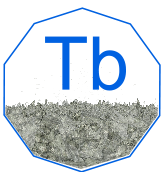Terbium

Terbium (Tb)
General Information
- Symbol: Tb
- Atomic Number: 65
- Atomic Weight: 158.92535 u
- Element Category: Lanthanide
- Group: N/A (Lanthanides series)
- Period: 6
- Block: f-block
Physical Properties
- Appearance: Silvery-white metallic
- Density: 8.23 g/cm³
- Melting Point: 1356 °C (2473 °F)
- Boiling Point: 3230 °C (5846 °F)
- Phase at STP: Solid
- Electron Configuration: [Xe] 4f⁹ 6s²
- Oxidation States: +3 (most common), +4
Chemical Properties
- Reactivity: Terbium is relatively stable in air but slowly tarnishes. It reacts with water to form terbium hydroxide and with acids to form terbium salts.
- Compounds: Forms compounds such as terbium(III) oxide (Tb₂O₃), terbium(III) chloride (TbCl₃), and terbium(III) nitrate (Tb(NO₃)₃).
Uses and Applications
- Phosphors: Used in green phosphors for color television tubes and fluorescent lamps.
- Magnets: Terbium is used in the production of magneto-optical storage media and in some advanced magnetic materials.
- Alloys: Added to other metals to improve their workability and durability.
- Lasers: Terbium-doped crystals are used in solid-state devices and lasers.
- Fuel Cells: Terbium oxide is used as a stabilizer in fuel cells.
- X-ray Devices: Used in certain types of X-ray and gamma-ray detectors.
Occurrence and Extraction
- Natural Occurrence: Found in minerals such as monazite, xenotime, and euxenite, often alongside other rare earth elements.
- Extraction: Extracted through complex processes involving the crushing of ore, magnetic separation, and solvent extraction.
Isotopes
- Stable Isotopes: Terbium-159 (the only naturally occurring isotope)
- Radioactive Isotopes: Several radioactive isotopes, including Terbium-158 and Terbium-160, used in research.
Safety and Handling
- Hazards: Terbium compounds are considered to have low toxicity, but dust and powders should be handled carefully to avoid inhalation or ingestion. Metallic terbium can be a fire hazard in powder form.
- Precautions: Use appropriate protective equipment when handling terbium and its compounds.
History
- Discovery: Discovered by Carl Gustaf Mosander in 1843.
- Name Origin: Named after the village of Ytterby in Sweden, where the mineral ytterbite (which contains terbium) was found.
Additional Facts
- Crystal Structure: Hexagonal close-packed (hcp) at low temperatures; body-centered cubic (bcc) at high temperatures
- Magnetic Properties: Paramagnetic at room temperature; ferromagnetic below 230 K
- Thermal Conductivity: 11.1 W/m·K
- Electrical Resistivity: 1.15 µΩ·m at 20°C
Summary
Terbium is a versatile lanthanide with a wide range of applications in industry and technology. It is particularly valuable in green phosphors for display screens, magneto-optical storage media, and fuel cells. Discovered in 1843 and named after the village of Ytterby in Sweden, terbium is found in several minerals and requires careful handling due to its reactive nature.
40 Question and Answer Pairs About Terbium
What is the atomic number of Terbium?
- 65
What is the symbol for Terbium?
- Tb
What is the atomic weight of Terbium?
- 158.92535 u
In which group of the periodic table is Terbium found?
- Lanthanides series (no specific group)
What period is Terbium in?
- Period 6
What block does Terbium belong to?
- f-block
What is the density of Terbium?
- 8.23 g/cm³
What is the melting point of Terbium?
- 1356 °C (2473 °F)
What is the boiling point of Terbium?
- 3230 °C (5846 °F)
What is the electron configuration of Terbium?
- [Xe] 4f⁹ 6s²
What are the common oxidation states of Terbium?
- +3 (most common), +4
What is the appearance of Terbium?
- Silvery-white metallic
Is Terbium reactive with air?
- Yes, it tarnishes slowly.
Name a compound of Terbium.
- Terbium(III) oxide (Tb₂O₃)
What is a common use of Terbium in phosphors?
- Used in green phosphors for color television tubes and fluorescent lamps.
How is Terbium used in the production of magnets?
- In magneto-optical storage media and advanced magnetic materials.
What role does Terbium play in alloys?
- Added to improve workability and durability.
How is Terbium used in lasers?
- Terbium-doped crystals are used in solid-state devices and lasers.
What is a fuel cell application of Terbium?
- Terbium oxide is used as a stabilizer.
How is Terbium typically found in nature?
- In minerals such as monazite, xenotime, and euxenite.
What is the most stable isotope of Terbium?
- Terbium-159
What safety hazard is associated with Terbium dust?
- It can be a fire hazard.
Who discovered Terbium?
- Carl Gustaf Mosander
Where does the name Terbium come from?
- Named after the village of Ytterby in Sweden.
What is the crystal structure of Terbium at low temperatures?
- Hexagonal close-packed (hcp)
Is Terbium paramagnetic or diamagnetic at room temperature?
- Paramagnetic
What is the thermal conductivity of Terbium?
- 11.1 W/m·K
What is the electrical resistivity of Terbium at 20°C?
- 1.15 µΩ·m
What is the primary oxidation state of Terbium in its compounds?
- +3
Is Terbium found as a free element in nature?
- No, it is found in minerals.
What is the common name of Terbium(III) chloride?
- TbCl₃
What is a major application of Terbium in the phosphor industry?
- Green phosphors for screens and fluorescent lamps.
How does Terbium benefit the magneto-optical storage industry?
- Used in magneto-optical storage media.
What is the melting point of Terbium in Kelvin?
- 1629 K
What group does Terbium belong to in the periodic table?
- Lanthanides series
What is the natural abundance of Terbium-159?
- It is the only naturally occurring isotope.
Can Terbium be used in high-temperature applications?
- Yes, particularly in fuel cells and advanced materials.
What is the key property that makes Terbium valuable in phosphors?
- Its ability to emit green light.
How is Terbium used in the chemical industry?
- Mainly in research and specialized applications.
What precautions should be taken when handling Terbium?
- Use appropriate protective equipment to avoid inhalation or ingestion.






